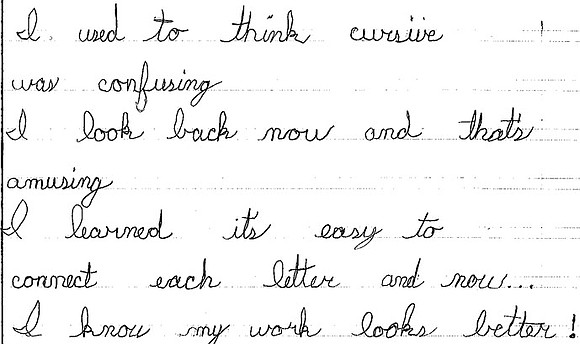BALTIMORE — While cursive has been left out of the national Common Core Standards, Maryland legislators have mandated the skill be taught.
Teachers from Maryland gathered at a seminar in Baltimore to discuss the most effective ways to teach handwriting to local students.
“Cursive instruction is very important to kids for a few major reasons,” said Todd Misura, a licensed occupational therapist for the Learning Without Tears, a Gaithersburg, Maryland-based service provider, whose mission is “to make learning and teaching easy and fun by providing superior educational products, training, and materials to educators and parents.”
The organization held seminars over two days in June to discuss cursive writing. Sessions have been held in various locations around the country.
“Children of elementary school love to write in cursive since it makes their writing look more mature than printed writing,” Misura said. “Many children will play write their signature well before they can actually learn cursive. This is an indicator that they are ready and eager to learn cursive.”
The workshop included sessions on printing basics and cursive instruction. Ultimately, educators learned how to use a simple and efficient handwriting techniques in the classroom.
“Research has shown a strong connection between handwork and brain development. My own children are learning cursive and ask me to read cursive papers to them,” said Crystal Esler, the administrator for Walden International School in North Bethesda who attended the Baltimore workshop. “I want my kids and students to be able to read cursive while they are in school and as an adult.”
Students often are excited when they learn to write in cursive because most believe only adults can do it, Esler continued.
“They like to have a signature for their name, and that’s important for them to have,” she said. “Cursive is a skill that lasts a lifetime. By attending the workshop, I learned a lot of great tips and tricks to use with students. It’s a great program.”
Once cursive has been learned and mastered, it leads to faster writing and, as the elementary school-aged child grows into middle school and beyond, they need to be able to take notes quickly, according to Misura.
“Note taking needs to be quick and efficient,” he said, adding that, for many children who enter higher-grade levels with messy printed handwriting, cursive becomes their salvation.
“These children can focus their attention on learning a new task from the beginning as opposed to trying to correct their inefficiencies when writing in print,” Misura said. “Much like if you learned how to swing a golf club or a tennis racket inefficiently; correcting the inefficient swing is tough. Had you learned [the] proper technique when you were first learning to swing, your game would be much improved.”
“Handwriting is the same way…just more complicated. The inefficiencies learned at an early age often stick with you. By teaching cursive, you can engage a child in new learning as opposed to correcting old habits. You don’t need to know how to print well before you learn cursive,” he said.
